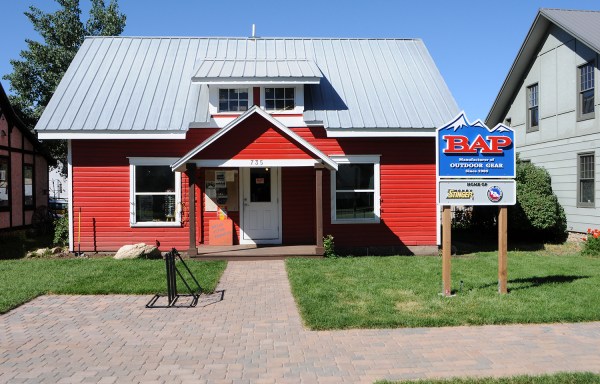Picture a serene meadow a few miles off the trailhead. The sun has just set, the stars are winking, and, while you’re out scouring for firewood, your tent is aglow in the distance.
There’s not a lantern, headlamp or flashlight illuminating the interior of your tent; it’s the new Big Agnes mtnGLO™ Tent Lighting Technology—a thin, ribbon-like strand of tiny LED lights sewn into the top seam of your tent to give you better visibility. They eliminate the inevitable scramble to find your headlamp minutes after it gets too dark to see it. And, the LEDs are just dim enough that if you turn them on in the middle of the night as you head out to use the john, your tentmate won’t wake up.
Big Agnes has always been known for innovation. Launched on an out-of-the-box sleep system in 2001, in which an inflatable sleeping pad was attached to the bottom of a sleeping bag via a sleeve, Big Agnes, based in Steamboat Springs, Colorado, is also known for its spacious and lightweight tents. Over the years the brand has designed all sorts of creative solutions for camping, from backpacking tents with car-camping-style headroom to two zipperless tents—one with magnetic closures and another with hooks.
“We’re dumb enough to throw something out there if we think it’s a cool idea,” says Bill Gamber, co-owner and co-founder of Big Agnes. “We don’t worry about what the consumer is going to say.”

We’re sitting in his office on the second floor of Steamboat Spring’s BAP! Store—a cute little red house that serves as the brick-and-mortar location for Gamber’s original company, Bwear Action Products (BAP), a collection of locally hand-sewn outdoor base layers. He started BAP with a pair of handmade bike shorts that he sold out of his college dorm room.
Gamber’s dog, Lola, a sweet-faced black lab, periodically pops up from where she lies to demand a head scratch. The office is unassuming—there are 1990s posters taped to the walls, piles of paperwork/catalogs/doodles/scratch paper cover Gamber’s desk, a pair of alpine-touring skis hold court in the corner, and the carpeting, with images of the solar system, is hard to miss. It’s obvious that Gamber, whose mind obviously never shuts off, spends a lot of time outside, which is exactly where the president of an outdoor gear company should be.
“We make gear that we want,” says Gamber, after talking about endless days of testing gear in the millions of wilderness acres surrounding Steamboat. “When we started with tents, we made them for backpacking. Then we started having kids, so we had to make them bigger for car-camping. That’s our research—using it, not market research. We take the risk.”
Luckily, the mtnGLO tent’s risk in terms of response seems narrow. Released in February, 2015, the mtnGLO integrated lighting system graces 14 tents, including 13 brand new designs. That’s one-third of Big Agnes’s entire tent line. Upon showcasing the technology for the first time at the Outdoor Retailer summer 2014 trade show in Salt Lake City—the biggest biannual gathering of the outdoor industry—Outside magazine awarded the Rattlesnake SL2 mtnGLO a Gear-of-the-Show award, a prize reserved for products that the magazine, an authority on outdoor gear, can’t wait to test.
“The actual idea of putting lights in a tent isn’t our unique idea. Every tent designer has thought of that,” says Gamber, explaining how their design process works. “It’s been my obsession for the past five years. Then, one day we had a string of LEDs so we set up a tent and that was it. With LEDs, you can bring a lot of light for not much expense, weight or need for power.” The idea gelled well with Big Agnes’s overarching vibe: the creature comforts of home in the backcountry.
Also sold as an accessory kit for any tent that has loops along the seam lines, mtnGLO has caused a bit of a controversy in the outdoor media. On one hand, the technology is winning awards from notable publications. On the other, purists are arguing that bringing lights into the backcountry is polluting an otherwise pristine environment. Gamber, who has lived off the grid for 25 years and is exceptionally aware of and efficient with his power use, tells me the bloggers are saying Big Agnes is creating a laser light show out there.
So, how bright are they really? After the interview with Gamber, I head over to one of Big Agnes’s shipping warehouses—there are a handful sprinkled throughout Steamboat Springs—where the marketing team has one set up. They turn the lights off in the warehouse and click on the lights in the tent. You’d have to strain to read a book under these rice grain-size lights, but sorting gear or playing cards would be doable. Laser light show? Nah. A headlamp, with its spot beam shooting around the woods, is probably more on par with a light show.
Conveniently, the LED strand’s on/off switch sits on a matchbox-size controller in a pocket near the top of the tent door. With two settings—on and 50% brightness—the LEDs are powered by three AAA batteries. Or, you can hook up the strand to a USB source like a solar panel. The lights can run for more than 90 hours and only add a slim 2–6 ounces, depending on whether you buy a tent with one or two strands.
The Gilpin Falls Powerhouse 4 mtnGLO tent, with two strands of lights, features a Joey T55 portable power source instead of the battery-operated controller—similar to what you find in, say, Timbuk2’s power-equipped laptop bags. You can bypass batteries as well as charge your phone, tablet or any other USB-powered device.
Through May, all 14 mtnGLO tents are available exclusively at REI—from a $250 backpacking tent to the $600 car-camp-friendly Gilpin Falls 4 mtnGLO. The collection has a size and price for just about everyone. Two styles—the Rattlesnake and Chimney Creek—will continue to be exclusively sold at REI through June 1 and August 1, respectively.
